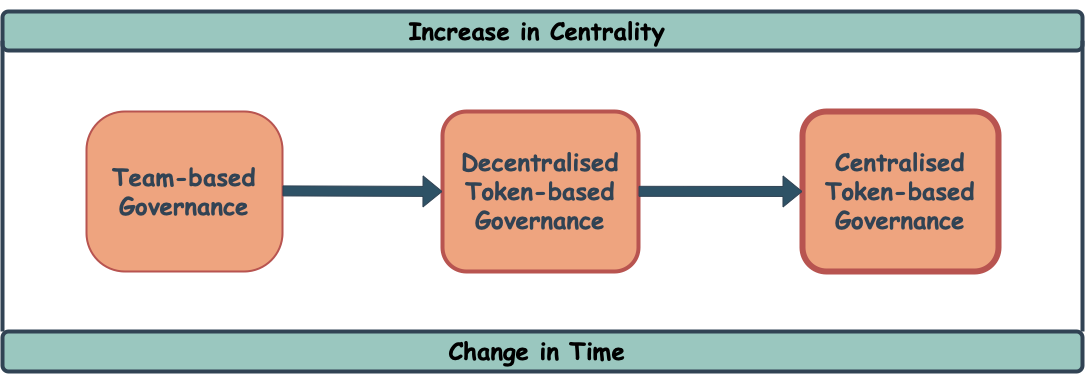Governance in DeFi#
Academic Insight
Key Insights
The voting power in DeFi protocols becomes increasingly concentrated among a percentage of token holders over time in decentralised exchanges, lending protocols and yield aggregators.
The paramount wallet addresses ranking within the top 5, 100, and 1000, exercise predominant influence over the voting power in the Balancer, Compound, Uniswap, and Yearn Finance protocols, with Compound displaying the least evidence of decentralisation.
The most significant governance challenges identified by DeFi users are voter collusion, low participation rates, and voter apathy.
To address vulnerabilities in DeFi governance, a novel voting mechanism resistant to sybil attacks called bond voting has been proposed.
To enhance the manual parameter section, an AI-enabled adjustment solution has been demonstrated to automate governance mechanisms.
Introduction#
Decentralised finance (DeFi) has emerged as a potential substitute for traditional financial institutions, offering peer-to-peer transactions and a diverse range of services that democratise finance by enabling users to participate in protocol governance. However, several studies have suggested that the current governance mechanisms require improvements. This article provides an overview of findings associated with DeFi governance.
Centralisation of Governance in DeFi Protocols#
Centralisation in DeFi has become a growing concern among researchers with several studies identifying a significant level of centrality in the governance mechanisms of DeFi protocol. Barbereau et al., [BSP+22a] found that the decentralisation of voting is significantly low with a majority of the voting power concentrated among a percentage of governance token holders. As evidenced by their findings, there was a significant degree of centrality, in lending protocols, decentralised exchanges and yield aggregators. This research work employed case studies to comprehend the governance mechanisms of these protocols.
Similarly, the result by Jensen et al. [JvWR21] demonstrates centrality in voting power with the protocols’ top 5, top 100, and top 1000 wallet addresses controlling the majority of the voting power in Balancer, Compound, Uniswap and Yearn Finance protocols. In this study, the token holdings and users’ wallets of protocols were analysed; Compound displayed the most evidence of centrality and Uniswap the least with the top 5 wallet addresses accounting for 42.1% and 12.05%, respectively.
Barbereau et al. [BSP+22b] ascertained that DeFi protocols become more centralised over time. In this longitudinal study, voting patterns demonstrated changes in the power dynamics as time progressed. The tendency for this centralisation of DeFi protocols is shown in [Fig. 19]. Furthermore, in analysing the governance structures of DeFi protocols, Stroponiati et al. [S+] ascribed reward-based economic incentives as the significant cause behind the development of centralised structures.

Fig. 19 The Tendency for Centralisation in DeFi Governance.#
Challenges & Vulnerability In DeFi Governance#
In investigating governance challenges, Ekal et al., [EAw22] identified voter collusion, low participation rates, and voter apathy as the most significant challenges. This empirical investigation utilised an interview survey approach to collect data from protocol users. Furthermore, to address voter concentration vulnerabilities, Mohan et al. [MKB22] proposed a novel voting mechanism called bond voting which is resistant to Sybil attacks. The bond voting mechanism issues ‘voting bonds’ to voters, which essentially requires a commitment to stake an amount of tokens, for a time period to gain voting power. Therefore, by combining this time commitment with weighted voting with a time commitment, Sybil attacks are more difficult. Quadratic voting, another solution to voting concentration, allows participants to convey both their preferences and the intensity of those preferences, however, the drawback of this mechanism is its vulnerability to Sybil attacks, voter collusion and voter fraud [KL22].
AI-enabled On-chain Governance#
To enhance and automate governance mechanisms, Xu et al., [XPFL23] demonstrated an AI-enabled parameter adjustment solution which is more efficient than current implementations. Specifically, the study employed Deep Q-network (DQN) reinforcement learning to investigate automated parameter selection in a DeFi environment. Although a lending protocol was employed in the study, the model’s application can extend to other categories of DeFi protocols as well. In investigating DAOs, Nabben [Nab23] observes that GitcoinDAO also employs algorithmic governance in various organisational components such as monitoring the compliance with rules of the organisation.
Conclusion#
The vision of DeFi is to foster a democratic process of governance and sustain high levels of decentralisation. However, recent studies have highlighted significant centrality in DeFi governance mechanisms, indicating the need for improvements in the existing governance models. The studies analysed in this article have revealed that the majority of the voting power in several protocols is concentrated among the top token holders, with evidence of increasing centralisation over time. Moreover, DeFi has been found to face challenges in the voting and governance process. In view of some of these challenges, researchers have proposed novel solutions such as bond voting and an AI-enabled parameter-selection solution to improve the current mechanisms. Given the importance of decentralisation in the underlying philosophy of DeFi, proposing more solutions to governance challenges is crucial for creating a more inclusive and democratic financial ecosystem. Therefore, continued research and development will certainly be required.
References#
- BSP+22a
Tom Barbereau, Reilly Smethurst, Orestis Papageorgiou, Alexander Rieger, and Gilbert Fridgen. Defi, not so decentralized: the measured distribution of voting rights. Hawaii International Conference on System Sciences (HICSS), 2022.
- BSP+22b
Tom Barbereau, Reilly Smethurst, Orestis Papageorgiou, Johannes Sedlmeir, and Gilbert Fridgen. Decentralised finance's unregulated governance: minority rule in the digital wild west. Available at SSRN, 2022.
- EAw22
Hassan Hamid Ekal and Shams N Abdul-wahab. Defi governance and decision-making on blockchain. Mesopotamian Journal of Computer Science, 2022:9–16, 2022.
- JvWR21
Johannes Rude Jensen, Victor von Wachter, and Omri Ross. How decentralized is the governance of blockchain-based finance: empirical evidence from four governance token distributions. arXiv preprint arXiv:2102.10096, 2021.
- KL22
Aggelos Kiayias and Philip Lazos. Sok: blockchain governance. arXiv preprint arXiv:2201.07188, 2022.
- MKB22
Vijay Mohan, Peyman Khezr, and Chris Berg. Voting with time commitment for decentralized governance: bond voting as a sybil-resistant mechanism. Available at SSRN, 2022.
- Nab23
Kelsie Nabben. Governance by algorithms, governance of algorithms: human-machine politics in decentralised autonomous organisations (daos). puntOorg International Journal, 8(1):36–54, 2023.
- S+
K Stroponiati and others. Decentralized governance in defi: examples and pitfalls. squarespace. retrieved december 30, 2022.
- XPFL23
Jiahua Xu, Daniel Perez, Yebo Feng, and Benjamin Livshits. Auto. gov: learning-based on-chain governance for decentralized finance (defi). arXiv preprint arXiv:2302.09551, 2023.
